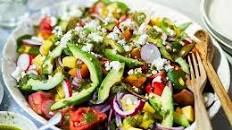Discover Quick and Delicious Easy Pasta Recipes to Try at Home

Delicious and Easy Pasta Recipes to Try at Home
Looking for quick and tasty meal ideas? Pasta is a versatile ingredient that can be transformed into a variety of delicious dishes with just a few simple ingredients. Whether you’re a novice cook or a seasoned chef, these easy pasta recipes are sure to satisfy your cravings:
Spaghetti Aglio e Olio
This classic Italian dish requires only a handful of ingredients – spaghetti, garlic, olive oil, red pepper flakes, and parsley. Cook the spaghetti until al dente, then sauté minced garlic in olive oil until fragrant. Toss the cooked pasta in the garlic-infused oil, sprinkle with red pepper flakes and chopped parsley, and voilà – a flavourful meal in minutes!
Creamy Mushroom Fettuccine
Sauté sliced mushrooms in butter until golden brown, then add cream and simmer until slightly thickened. Toss cooked fettuccine in the creamy mushroom sauce, season with salt and pepper, and garnish with fresh parsley. This indulgent dish is perfect for a cosy night in.
Pesto Pasta with Cherry Tomatoes
Cook your favourite pasta shape according to package instructions. In a blender, combine fresh basil leaves, pine nuts, Parmesan cheese, garlic, and olive oil to make the pesto sauce. Toss the cooked pasta with the pesto and halved cherry tomatoes for a vibrant and flavourful meal.
These easy pasta recipes are not only delicious but also perfect for busy weeknights or lazy weekends. Get creative with your ingredients and enjoy a comforting bowl of pasta whenever the craving strikes!
7 Essential Tips for Mastering Easy Pasta Recipes
- Choose the right pasta shape for your sauce.
- Cook pasta in a large pot of salted boiling water.
- Reserve some pasta water before draining to use in the sauce.
- Don’t overcook the pasta; it should be al dente.
- Mix hot pasta with the sauce off the heat to allow flavours to meld.
- Top with fresh herbs or grated Parmesan cheese for extra flavour.
- Experiment with different ingredients to create unique pasta dishes.
Choose the right pasta shape for your sauce.
When preparing easy pasta recipes, it is essential to choose the right pasta shape that complements your sauce. Different pasta shapes are designed to hold specific types of sauces, enhancing the overall flavour and texture of the dish. For example, long and thin pasta like spaghetti pairs well with light olive oil or tomato-based sauces, while tube-shaped pasta like penne is ideal for hearty meat or cream-based sauces. By selecting the appropriate pasta shape for your sauce, you can elevate the dining experience and create a harmonious blend of flavours in every bite.
Cook pasta in a large pot of salted boiling water.
To ensure perfectly cooked pasta, it is essential to use a large pot of salted boiling water. The ample water volume allows the pasta to move freely and cook evenly, preventing it from sticking together. Adding salt to the water not only seasons the pasta but also enhances its flavour. By following this simple tip, you can elevate your easy pasta recipes and create dishes that are both delicious and satisfying.
Reserve some pasta water before draining to use in the sauce.
A helpful tip for enhancing your easy pasta recipes is to reserve a small amount of the pasta cooking water before draining. This starchy water can be a secret weapon in creating a velvety and cohesive sauce for your pasta dishes. By adding a splash of the reserved pasta water to your sauce, you can help bind the ingredients together and achieve a silky texture that clings to the pasta perfectly. Next time you’re cooking up a batch of pasta, remember to save some of the cooking water for an extra flavourful and satisfying meal.
Don’t overcook the pasta; it should be al dente.
When preparing easy pasta recipes, a crucial tip to remember is not to overcook the pasta; it should be al dente. Al dente, an Italian term meaning “to the tooth,” refers to pasta that is cooked just enough to retain a slight firmness or bite when chewed. Achieving al dente pasta ensures a perfect texture and enhances the overall dish, allowing it to hold sauces better and deliver a more satisfying dining experience. So, keep a close eye on your cooking time and taste-testing to ensure your pasta is cooked to perfection every time.
Mix hot pasta with the sauce off the heat to allow flavours to meld.
When preparing easy pasta recipes, a helpful tip to enhance the dish’s flavour is to mix the hot pasta with the sauce off the heat. This technique allows the pasta to absorb the flavours of the sauce more effectively, resulting in a harmonious melding of tastes. By combining the pasta and sauce away from direct heat, you can ensure that each bite is infused with delicious and well-balanced flavours, making your meal even more enjoyable.
Top with fresh herbs or grated Parmesan cheese for extra flavour.
Enhance the taste of your easy pasta recipes by adding a finishing touch of freshness with a sprinkle of fragrant fresh herbs or a generous dusting of grated Parmesan cheese. These simple yet impactful additions can elevate the flavours of your dish, providing a burst of aromatic herbs or a rich, savoury note from the cheese. Experiment with different combinations to create a personalised and delicious pasta experience that is sure to impress your taste buds.
Experiment with different ingredients to create unique pasta dishes.
To elevate your pasta game, why not experiment with an array of ingredients to craft unique and innovative pasta dishes? By thinking outside the box and incorporating unexpected flavours and textures, you can transform a simple pasta meal into a culinary masterpiece. Consider adding ingredients like sun-dried tomatoes, artichokes, pancetta, or even fruits like lemon or figs to create a dish that tantalises your taste buds and surprises your guests. Embrace creativity in the kitchen and let your imagination guide you towards creating unforgettable pasta creations that reflect your personal style and preferences.



